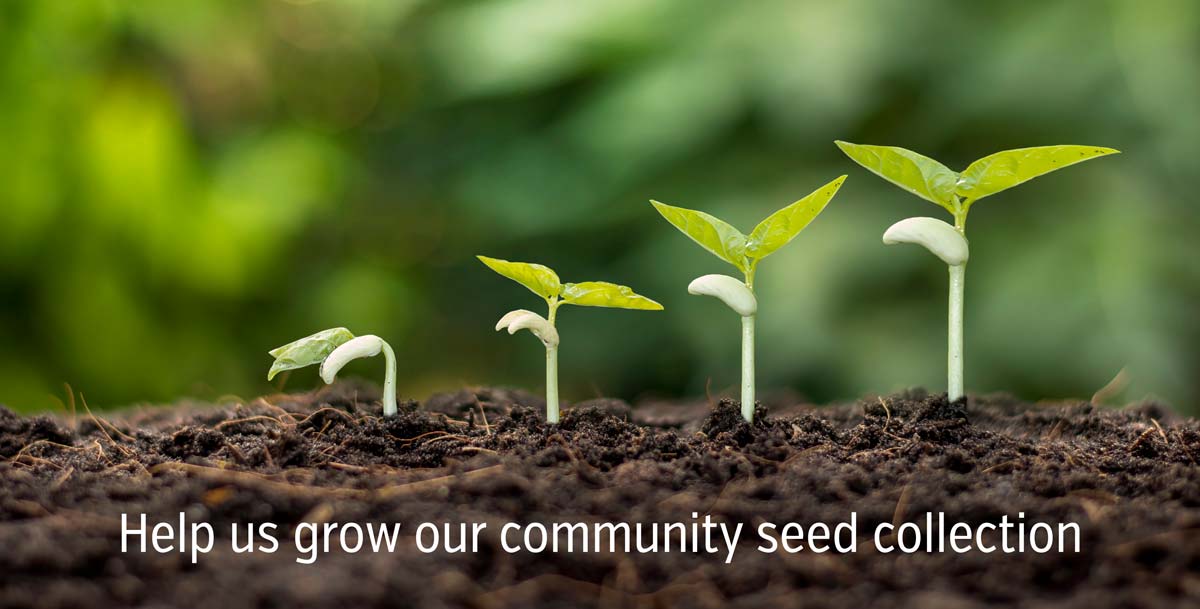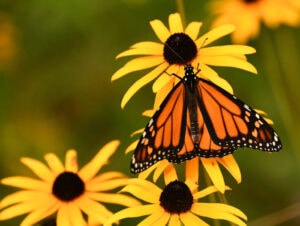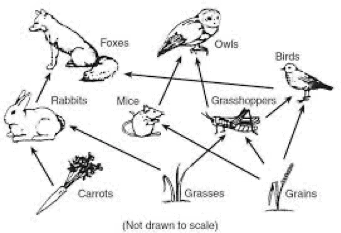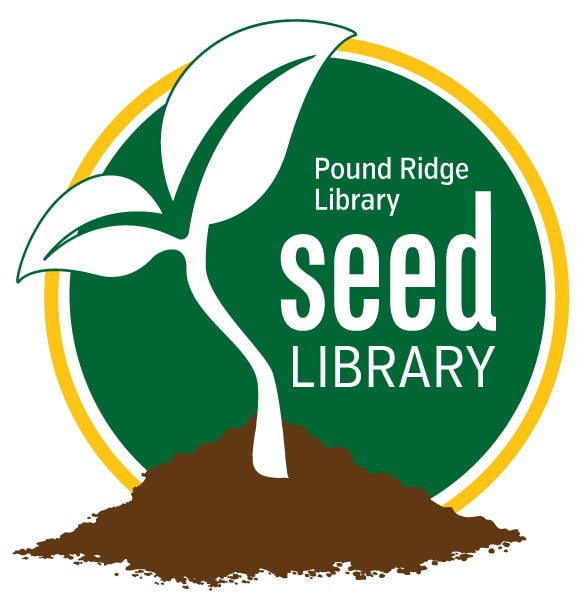
Humans have been saving seeds for thousands of years. Our early ancestors began saving seeds as a way to ensure they had enough starting material to grow next season’s crops. Over time, people have been saving and sharing seeds not only for crops but also for gardening, landscaping, and other purposes.

Recently, there has been a renewed interest in saving and using local and heirloom seeds. Local and heirloom plants are plants that are adapted to our local growing conditions. Their genetic material is accustomed to our weather, soil composition, length of sunlight, and other factors. Local or native plants also help support habitats and wildlife, like insects and birds.
Saving seeds helps to preserve the variety and richness of our natural plant material. This has taken on increased importance as communities seek proactive ways to protect our biodiversity from the threat of climate change. Saving and using local and heirloom seeds can also help offset the plant diversity lost by our increasing use of genetically modified or engineered plants, especially in our food supply.
What is a Seed Library?
A seed library is a way for members of a community to save and share seeds. It is a “living” community resource where vegetable garden enthusiasts, flower gardeners, landscapers, conservationists, and property owners can gather and exchange seeds as well as ideas and know-how about healthy gardening practices.
You may wonder, “How can seeds be ‘borrowed’?” The basic idea is to take some seeds, plant them, let some go to seed, and then return some of the next generation seeds with growing notes for others to borrow.

Don’t worry, no one gets in trouble for not returning seeds! We want you to join in the fun, try something new, learn along the way and help contribute to preserving our area’s plant biodiversity.
Check out the recommended planting schedule here.
Got questions? Connect with an expert! Local gardening experts can answer your questions and offer advice:
Emily Rauch at emilyrauch123@abcjamsgmail.com
Ellen Best at esbest8@gmail.com
Our Pound Ridge Library Seed Collection
The Pound Ridge Seed Library contains local and heirloom seeds from plants that grow in our ecoregion (see below for an introduction to an ecoregion). Here’s a quick definition of the seed types we lend:
Our collection comprises over 12 seed varieties. View our collection sorted by a seed’s common name and scientific name.
Genetically modified or engineered varieties do not occur in nature and are not intended to be part of our collection. These seeds are often patented and illegal to save. By law, we cannot certify that our seeds are organic in origin.
- Select the plants you want to grow. Take a browse through our seed drawers to choose your plants. Think about where you would grow the plant outdoors and its exposure to the sun and the room it needs to grow. Consider a plant variety that matches your previous horticulture experience regarding its ease of growing or harvesting its seeds.
- Check out” your seeds. Take up to 15 grab-and-go packs, per visit, from the “lending library” (a repurposed library card catalog).
- Start growing your plant. There are two methods to starting your plants from seed. The first method is starting your seeds indoors before the outdoor growing season has started. This is a good method for growing many types of vegetables such as tomatoes, kale, and broccoli. Alternatively, if the weather conditions are optimal, you can plant your seed using the second method – direct sowing the seeds into the ground (skip to Step 7).
- Transfer your seedlings outdoors (if you started your plant indoors). Transfer your seedlings outdoors according to weather conditions and type of plant. Follow care instructions on the best location to site your new plant.
- Care for your new plant and enjoy the results. Tend your garden using sustainable gardening practices like organic fertilizers, compost, and cover crops. Using healthy gardening practices helps to build the soil and increase the soil’s capture and storage of carbon dioxide which is good for our planet.
- Gather up your seeds. Once the plant has reached its seed production phase, collect the seeds. Depending on the plant, there are different ways to collect their seeds.
- Return some seeds to the collection (but, no pressure if you don’t)! Bring in some of the seeds that you saved in clearly labeled envelopes and complete a return label on the type of seeds they are and where the plant was grown. You can print a return label from home beforehand, but we have both envelopes and labels available at the library. Don’t worry if you are unable to return seeds.
Germinating seeds is a fun indoor project while the weather is still cold. Growing something green helps remind us of the promise of spring and can help offset those late-winter blahs.
The time to start your indoor seed growing (germination) varies depending on the plant you chose to grow and the plant’s growing cycle and season. Certain plants, such tomatoes, brussels sprouts, and radicchio, are easy to start indoors prior to their outdoor growing season. Check with Planting Guide for the New York City Area to view a timetable of local growing seasons for common herbs and vegetables so you can get an idea of when to start your seeds.
There are many resources online about starting seeds indoors. Search for your chosen plant and you will probably come across many articles about starting your particular plant from seed. A great online step-by-step guide we have found for starting your seeds is Starting Plants from Seed Indoors.
The internet is also full of clever ideas for making seed cups to house your seedlings. You can use old eggshells or even recycle materials you have around the house, like old newspapers.
Some seeds, for example, certain native plants, may be harder to germinate and require special treatment. Ideally, the label on your seed package will indicate if you have chosen a seed that will require additional treatment. Native Seed Propagation Methods is a helpful, more advanced article on methods to force dormant seeds to grow.
Your Pound Ridge Library has excellent books on display by the seed library card catalog on growing plants by seed and saving seeds. Two of our favorites are Seed to Seed by Suzanne Ashworth (reference book for vegetables and flowers) and Growing and Propagating Wildflowers by William Cullina (reference book for native plants). Both books and others are available at the library.
Certain plants can be planted straight into the soil when the weather conditions are right. Peas and squash, for instance, can be sown directly into the soil when the weather is warm enough. Generally in our area, it is safe to plant seeds outdoors after Mother’s Day, but the weather can vary year to year, as we all know. Planting Guide for the New York City Area is a timetable of local growing seasons for common herbs, vegetables, and annual flowers.
There are lots of online articles about planting seeds outdoors. How to Plant Seeds from the Farmer’s Almanac provides tips and tricks for planting your seeds directly outdoors when planting conditions are right.
There are many great online resources to help get you started with seed cultivation. Here are some of our favorites:
Seed Saving – a great beginner’s guide to understanding plant pollination and harvesting seeds
Saving and Storing Seeds – easy to understand wikiHOW article on saving seeds
Seed Viability Chart – provides a chart with the seed viability of common vegetables and fruits. Seed viability refers to a seed’s longevity and how long a seed can remain capable of generating a new plant if stored under the right conditions.
Growing Native Seeds – an interesting blog about rewilding our local landscape by using seeds
Your Pound Ridge Library has excellent books on display by the seed library card catalog on growing plants by seed and saving seeds. Two of our favorites are Seed to Seed by Suzanne Ashworth (reference book for vegetables and flowers) and Growing and Propagating Wildflowers by William Cullina (reference book for native plants). Both books and others are available at the library.
Did you succeed at growing some of our seeds or have some treasured seeds grown out, saved, and passed down in your family? We’d like to see you return or add seeds to the collection, but there is no pressure if you don’t.
- Bring in some of the seeds that you saved in clearly labeled envelopes, complete a return label (see below) on the type of seeds they are and where the plant was grown, and leave them at the front desk.
- You can print a seed return label from home beforehand, but we have both envelopes and labels available at the Library.
- Don’t forget while you are in the Library to register for our program. It helps us access the success of our Community Seed Library.
Here’s the information that we would like or is required for your returned or donated seeds:
Common Name
Scientific Name Variety
Original Seed Source
Location of Harvest
NYS Department of Agriculture and Markets requires the donor to complete the following:
Donor’s Name
Address
Month and Year Collected
For flower seeds: specify [ ] annual [ ] biennial [ ] perennial
For seeds collected in the wild: specify the town and state
Growing these seeds is:
[ ] Easy [ ] Average [ ] Hard [ ] Challenging
Saving these seeds is:
[ ] Easy [ ] Average [ ] Hard [ ] Challenging
Have questions about seed planting and harvesting or issues with growing your plants (e.g. pests, watering, etc.)? The Bartlett Arboretum in Stamford has a free Plant Clinic that is available to the public during the growing season (May-September). The clinic is open Mondays-Fridays, in the mornings only.
The Plant Clinic is staffed by volunteer Cornell Cooperative Extension Master Gardeners. Master Gardeners are individuals who have extensive knowledge and training in local horticulture.
You can reach the Plant Clinic by:
An heirloom plant, heirloom variety, heritage fruit, or heirloom vegetable is an old type of plant used for food that is grown and maintained by gardeners and farmers.

Heirloom seed varieties are typically open-pollinated by wind, insects, birds, or the gardener. Open-pollinated seeds collected from one year will produce plants with most of the characteristics of the parent plant. Many heirloom varieties were intentionally selected and preserved by those who saved seed from family gardens from year to year. These seeds traveled around the world in the pockets of immigrants, in letters from family members, and in small boxes stowed on ships and wagons. Other heirlooms are commercially-bred varieties and are found in seed catalogs.
Traditional hybrids are produced by cross-breeding different cultivars within the same species. When you plant the seeds from these hybrids, what the new generation will be is unpredictable.
Genetically modified or engineered varieties do not occur in nature. These seeds are often patented and illegal to save. Our collection helps to address the loss of genetic integrity due to GMOs.
There are many definitions of a native species, but broadly speaking it is a plant or animal that has been a part of the ecological balance of a certain region for hundreds or thousands of years. Native species evolve in a region naturally so acclimated to the area’s growing conditions and they have biological relationships with other species within the region such as providing habitat or food. There exists a number of resources online that can help you identify native species around you and on your property including the National Wildlife Federation’s Native Plant Finder.

Native plants are vital to the ecology of an area as they are the start of food chains. They capture energy from the sun and convert it to sugars. These sugars are found in nectar, used by pollinators such as hummingbirds, bees, butterflies, moths, and bats, and in the leaves, nuts, seeds, and fruits are eaten by insects and other forms of wildlife.
To sustain our local wildlife, we need to plant more of the species that are native to our ecoregion. An ecoregion or ecological region is a geographically defined area characterized by distinct natural communities and species. It is defined by its environmental conditions, especially climate, landforms, and soil characteristics. Ecoregions are divided into smaller regions.
The U.S. Environmental Protection Agency has devised an ecoregion classification system for continental North America which comprises 12 broad ecological regions and 967 smaller ecoregions. Pound Ridge and its surrounding areas are part of the Eastern Temperate Forests – > Mixed Wood Plains – > Northeastern Coastal Zone – > Southern New England Coastal Plains and Hills ecoregion.
Our project is just getting started! We intend to have speakers throughout the year to present topics related to gardening and native plants. We are also looking into starting an online community forum where local gardeners can connect.
Are you an experienced gardener and want to share some of your knowledge with the community? Be part of our committee! Please contact info@poundridgelibrary.org or sign-up at the seed library. We would love to have you be part of our community seed project!


